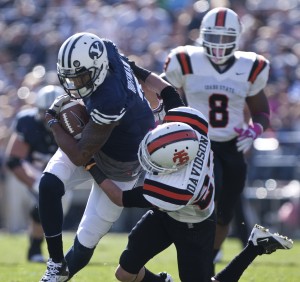The schedules of college football teams across the nation can be both a matter of sportsmanship and finances, as larger universities pay smaller ones to give them an “easy” game.
Local Football Championship Subdivision (FCS) schools, such as Idaho State and Weber State, have to run their athletic programs with significantly fewer revenue sources compared to schools like BYU and the University of Utah.
The Idaho State Bengals football team, a member of the FCS, will come to Provo to play BYU on Nov. 16. For the casual fan, this may seem like just a game between mismatched teams. However, beyond the hashes at LaVell Edwards Stadium lies a deeper meaning to this game for the Bengals.

There will be 110 FCS vs. Football Bowl Subdivision (FBS) games in the 2013 football season. According to Idaho State Athletic Director Jeff Tingey, most FCS teams don’t have a choice but to play in a payout game.
“We will have one every year,” Tingey said. “We have budget constraints that constrain us to do this.”
To make up for the difference in revenue that FCS teams don’t see from TV contracts, bowl games, ticket sales and major corporate sponsors, they play one game per year against an FBS opponent and receive a significant payout.
Weber State received $400,000 from the University of Utah for their game on Sept. 7. Utah won 70-7. A request for financial information regarding financial exchanges between BYU and Idaho State was not returned.
Weber State Media Relations director Paul Grua explained the necessity of these games for FCS schools across the nation.
“Our budget is not nearly as big,” Grua said. “We certainly lack that income from a TV contract. So these are opportunities to play FBS to get some money. Everyone at our level does this.”
Tingey further explained the constraints of FCS teams that require them to play in payout games.
“Schools like Utah and BYU have a larger contingent for their teams,” Tingey said. “They have more coaches. BYU can give out 85 scholarships, but we only have 63. In the end we all need to produce revenue but not in the same way. These games help schools at our level supplement our budgets.”
The money FCS football teams receive is essential for every athletic program the university fields, from softball to wrestling.
“It all goes to the general pod,” Grua said. “It helps with other areas or departments as well.”
An FCS upset provides the school with additional financial aid aside from the guaranteed payout. A victory over an FBS school can provide the FCS school unprecedented attention from national media exposure.
“It would definitely propel us into national exposure,” Grua said. “It would create great publicity.”
On top of providing funds to help run their athletic programs, payout games provide FCS teams with a game day environment they normally don’t experience.
“We absolutely love playing these games,” Tingey said. “Playing on a larger stage such as BYU is an experience that many of our young men will only see on television. To play on that field themselves is a great experience that they will cherish.”
Despite the competitive advantages and usual blowouts, FBS teams shouldn’t treat FCS teams too lightly.
Seven FCS teams upset an FBS school during the first week of the 2013 season, which set a new record for amount of upsets in a week. The FCS teams raked in a combined $2.375 million from the games.
Marcus Mathews, a wide receiver on the BYU football team, said players and coaches realize the potential of an upset.
“Our coaches try really hard to prepare us the same regardless of the opponent,” Mathews said.
The Bengals certainly are coming into Provo with “upset” on their minds.
“It would be a terrible predicament to go into a game with no aspirations and no hope of winning,” Tingey said. “We have a lot of different goals, and winning is one of them.”




